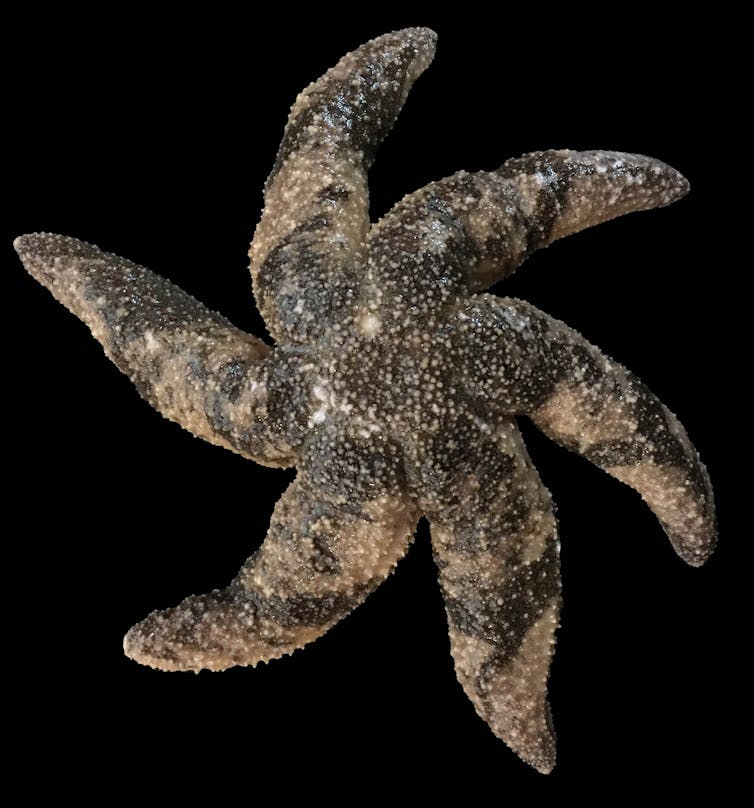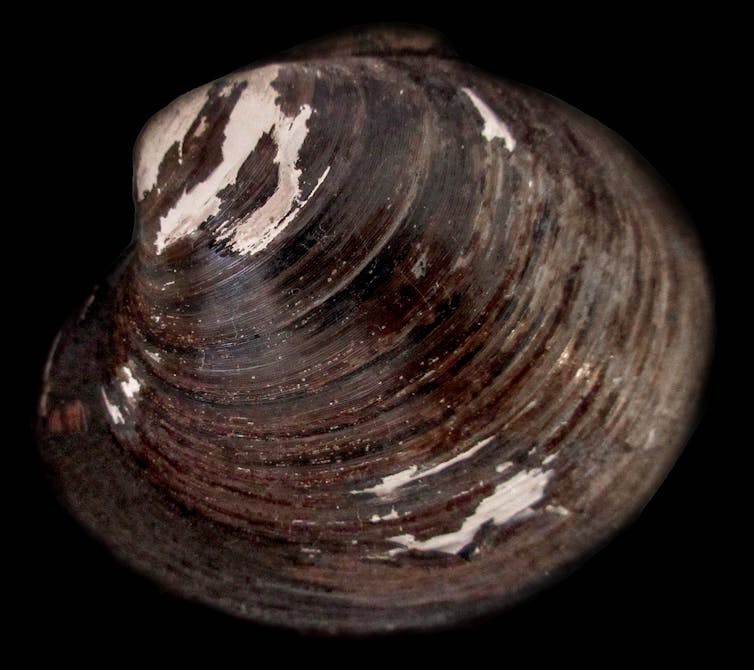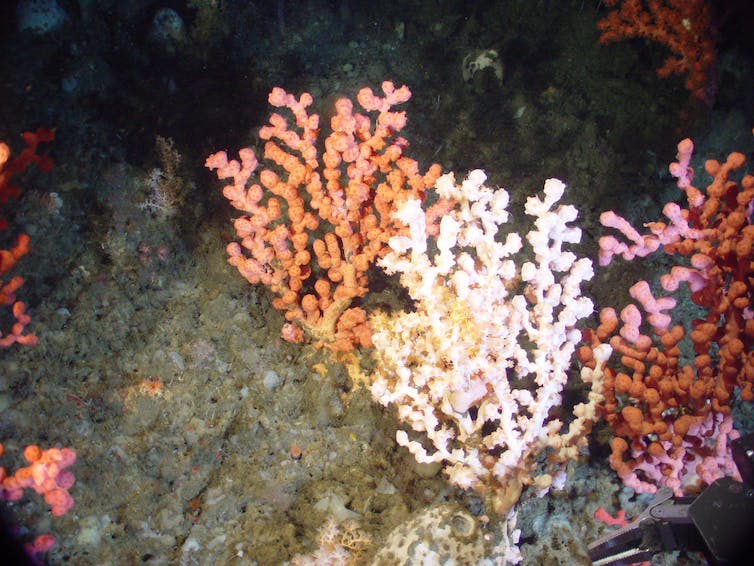In the vast St. Lawrence River, an impressive variety of animals live on the seabed. This group of organisms is called benthos.
These organisms live either buried in the sediment (infaunas) or on the surface of the seabed (epibenthos). Benthic invertebrates have no backbone, are not very mobile and are generally small.
And they are far from being rare. As far back as 1988 researchers listed over 1,855 species of benthic invertebrates living in the estuary and gulf of the St. Lawrence River. These represent 84 per cent of all invertebrate species in the St. Lawrence waters.
Needless to say, many new species have been identified since then, and our knowledge about them continues to grow.
As specialists in benthic ecology, we invite you to discover the benthos through six special features that are certain to pique your curiosity.
Luminous worms
Like earthworms in our gardens, marine worms inhabit the ocean floor. They come in all shapes and sizes, and some are even covered in scales. But their originality doesn’t stop there. Some of these worms are actually capable of bioluminescence. The production of light in the form of luminous flashes has three general functions: defensive (to escape predators), offensive (in support of predation) and communicative (for reproduction).
In the St. Lawrence River, the only scale worms with this ability are of the Harmothoe genus, of which there are five species. These species can be found on both clay and rocky bottoms in both coastal and deep-water areas.
Are corals cold?
For many, oceans bring to mind vacations, heat, diving and coral reefs. But does coral only grow in warm waters? Absolutely not. Some 20 species live in the salty waters of the St. Lawrence ecosystems and this number triples if we include the East Coast of Canada.
But what is coral? Corals are actually marine polyps, cylindrical animals with a mouth surrounded by a ring of tentacles, that secrete a molecule called calcium carbonate to form a skeleton.
There are two types: soft corals, with an internal skeleton that reinforces the structure of the colony (a collection of cloned individuals) while ensuring its elasticity, and hard corals, where each polyp secretes a cup-shaped external skeleton, creating their characteristic rigidity.
Not only do corals inhabit the cold waters of the St. Lawrence, but the species that holds the title of largest marine invertebrate on the planet is present at the entrance to the Gulf, notably on the rocky slopes of the Scotian Shelf. This is the Paragorgia arborea, some colonies of which can reach six metres in height.
(Fisheries and Oceans Canada), Fourni par l’auteur
Starfish: dreaded gourmets
Starfish are so colourful and pretty you can find them in souvenir stores, but don’t be fooled by their appearance. They are actually fearsome predators, and understanding how they feed will likely change the way you see them.
Faced with the two greediest species in the St. Lawrence (Asterias rubens and Leptasterias polaris), mussels normally have nothing to fear. But thanks to dozens of ambulacral feet — little suckers on their underside — starfish can easily open mussels. As soon as the mussel shows a sign of weakness, the starfish is able to extract its own stomach from its body and insert it into the mussel, where on contact with the flesh, it begins digesting it. In this rather unusual situation the meal can last around 10 hours. Afterwards, the starfish swallows its stomach again and starts hunting for new prey.

(Cindy Grant), Fourni par l’auteur
You said centenarian?
Present in the Gulf of St. Lawrence, particularly in the Magdalen Islands, the Northern quahog (Arctica islandica) is the world’s longest-living animal. It is a bivalve mollusc protected by a calcareous shell with two valves, like that of a mussel or oyster. The Northern quahog can easily live up to 200 years, but the oldest specimen, recorded in Iceland, was 507 years old.

(Lisa Treau De Coeli), Fourni par l’auteur
Other bivalves are known to live long lives. The age of these molluscs can be determined by the growth rings on their shells, rather like trees, but the technique here is called sclerochronology. It is even possible to read the history of the climate on the shells of several bivalves and use this information to predict future conditions.
Worms, medicine and the Olympics
Arenicolous worms (Arenicola marina) can be identified by the typical shape of their burrows (a mound of small wiggles), which can be seen at low tide on the St. Lawrence coast.
Although seemingly trivial, these marine worms could enable major advances in medicine thanks to their hemoglobin, which is capable of transporting up to 50 times more oxygen than that of humans. This particular property enables the worms to store oxygen from seawater at high tide and use this reserve at low tide.
In medicine, the hemoglobin of the arenicolous worm could be used to improve organ preservation during transplants, to make oxygenating dressings or to develop a blood substitute for emergency transfusions.
Although this worm could revolutionize medicine, it could also pose problems for anti-doping agencies and athletes. Virtually undetectable and hyper-performing, the incredible oxygenating benefits of the arenicolous worm’s hemoglobin could undoubtedly boost athletes’ performance at the next Olympics.
Natural “crazy glue”
Although mussels are tossed about by breaking waves all day long, they still manage to hold tight to the rocks. Their secret? The byssus, a collection of hair-sized fibres that are both strong and elastic.
The proteins that make up byssus form natural ‘crazy glue’; this liquid glue hardens rapidly, enabling the mussel to adhere with unrivalled tenacity to virtually any surface, even wet ones.
The unusual properties of byssus have fascinated humans since ancient times. In days gone by, these filaments of “marine silk” were used to weave luxurious garments. More recently, the particular chemical composition of the sticky proteins derived from byssal threads has inspired the creation of underwater adhesives and surgical glues.
In conclusion, while the epifauna of the St. Lawrence is relatively well known, knowledge of the endofauna remains sparse and patchy, even in 2023. Initiatives are underway to discover and characterize this sediment-dwelling fauna.
These studies will undoubtedly lead to the discovery of other exciting facts about the benthos.




